While we move about the city using public transportation … so too do a diversity of insects. Where are they going and why?
Every day I make the commute between my home in a rural-style village on an “outlying island” (Lamma Island) to the middle of the city in Hong Kong. Altogether the journey is about one hour one way and involves walking, a ferry, and a subway/MTR ride. A variety of things can happen to me on any particular day that can liven up the commute. But certainly, one of my favorites is finding a butterfly or moth joining me on my journey.
Not infrequently, when I get on the ferry from Lamma to Hong Kong Island I will find moths in the boat. Sometimes large and conspicuous ones (e.g. Macroglossum species, or the hummingbird moths) wind up flying and buzzing around frightened passengers. I do my best to jump in and save the day, capture them safely and release them.
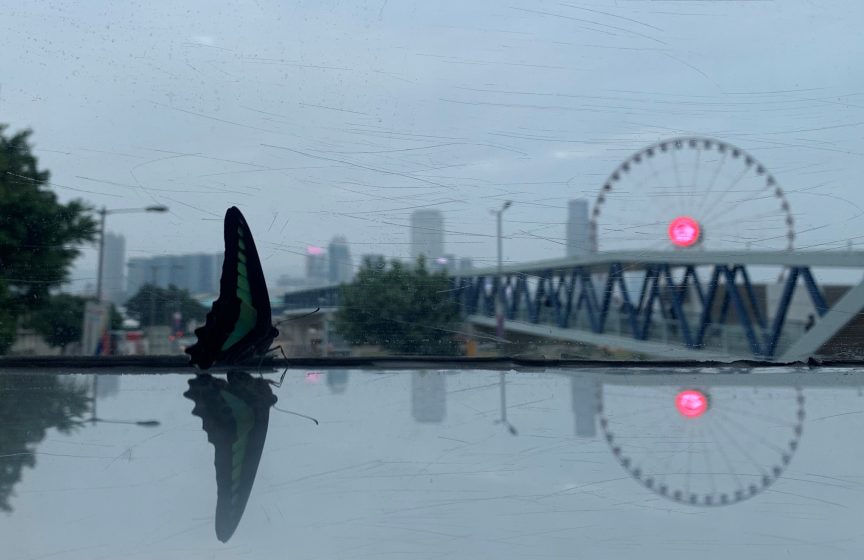
But where do I release them? If I let one go over the water it usually results in the insect dropping straight into the water – fish food. I’ve learned this the hard way and I now avoid such careless releases. If I’m in transit however, do I let them go on the city side even if they originated on the rural side? Presumably they’re not trying to get to the city like I am. But who am I to judge? If they’re flying away from rural Lamma then perhaps they are looking for new habitat on a different island. I wonder about this a lot…but I usually release them wherever I get off next and hope they find their way to a decent new home (or office?).
In all likelihood I assume that most of the insects I meet in transit are not there by choice. Especially for moths, light is likely the main culprit in attracting them to these unfamiliar habitats. I also suspect that in many cases the individuals are dispersing from the habitat where they originated but end up in these spaces unintentionally. At least for Lepidoptera, most of these species will be unable to persist in these highly urbanized and fast-moving spaces (boats, cars, or subway terminals).
This doesn’t mean that they can’t escape on their own. Sometimes if I’m in a hurry, or if a butterfly seems to be on a mission (looking for mates… or a good brunch spot perhaps), I will let it be. My guess is that some proportion (probably low) do find their way to more hospitable environments where they may thrive and reproduce.
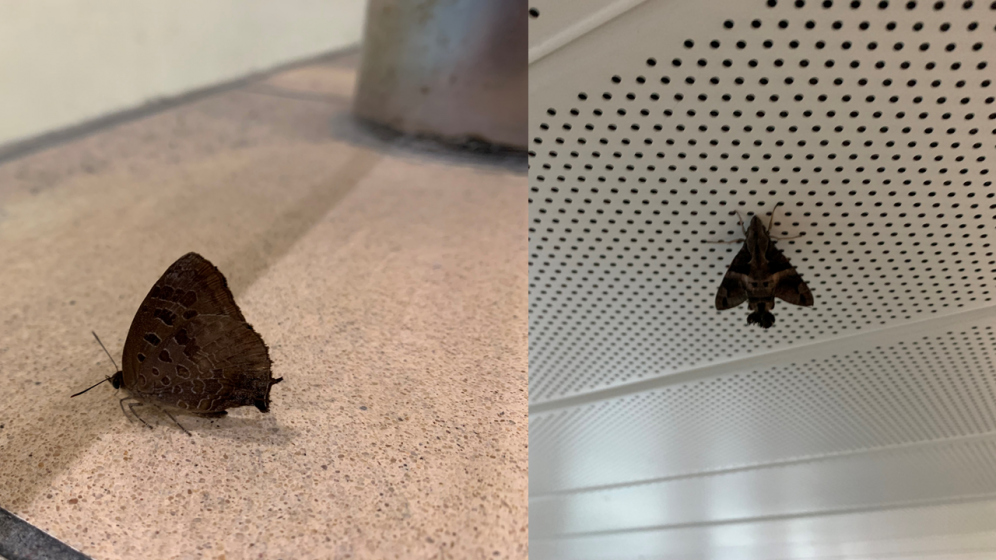
Unfortunately, most of the six-legged friends I make on my commute are probably not going to survive much longer. If I’m honest with myself, I know that these interactions are really a sign of human imposition into a landscape where humanity and other species are struggling to coexist.
There’s the additional issue of public transit, and private transit of course, affecting dispersal of species and having consequences for ecological communities. If I release a hummingbird moth that originated from Hong Kong Island to another island, where perhaps there are not natural populations of these species, is there a chance that a new population will establish and displace native species? This thought is nearly always in the back of my mind when I release insects from urban infrastructure traps during my commute. In Hong Kong, this is unlikely to be the case as the ecological communities across islands are fairly well mixed and they are pretty close to one another. But I imagine this is an issue in some contexts.
I’ve concluded that ultimately these short-term “commutes” of species accompanying my transit, along with those of millions of other city dwellers, is probably inconsequential given the scale (within the city) and the variety of other impacts humans bring to the environment. There may be some homogenization of biodiversity resulting from these human-aided dispersal events but (1) most are occurring at relatively short distances, and (2) most individuals are not likely to persist for a long time following the dispersal event (assuming they survive the transit at all).
Between cities is another matter. A classic study was conducted by Von Der Lippe and Kowarik (2008) in Berlin – by placing seed traps along a motorway and comparing seed sets from the outgoing lane (away from the city) vs the incoming lane (into the city) they found significantly higher levels of non-native plants (and a higher overall level of seed deposition) being dispersed out of the city than into it. In this way, at larger spatial scales it appears likely that roads and transit pathways between cities could be changing biodiversity in those cities and the landscapes between them.
There also bound to be evolutionary consequences for some species who encounter such transit infrastructure frequently. Urban moths exposed long-term to high levels of light pollution can evolve to reduce their flight-to-light behaviors which would lower the probability of being trapped in subway stations or walkway structures. I imagine urban butterflies evolving to read subway maps, or perhaps figuring out clever ways of downloading music to more easily pass the time during their dispersal events.
Anyway, there are interesting implications surrounding the unexpected commuters we may meet on the bus, boat, or in our car. Certainly, the consequences of urban and transit infrastructure on local biodiversity is a subject in need of continued study. New ways of thinking about such infrastructure to accommodate our commuter companions could help to facilitate their movement.
But most of all, when I am lucky enough to find a cool bug while mindlessly going about my day moving through the city trying to get to work — I try to stop and appreciate my fellow commuter. I imagine its own journey, more epic than my own given our relative sizes and the massive skyscrapers towering above us. Such chance meetings are a wonderful reminder of the animals that mirror our movements through urban pathways and transportation corridors. These creatures are doing some amazing things. By comparison my own commute feels rather dull…but all together it’s really very cool; our rapidly zig-zagging and chaotic trajectories — fluttering, hopping and brisk walking — interweaving through complex vertical and horizontal concrete masses. All of us ending up somewhere new where exciting adventures await.
Timothy C. Bonebrake
Hong Kong



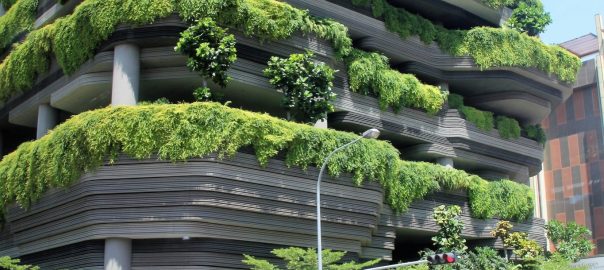
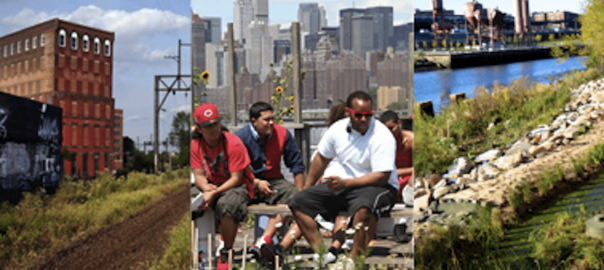
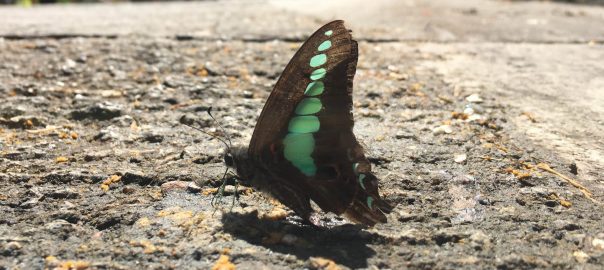
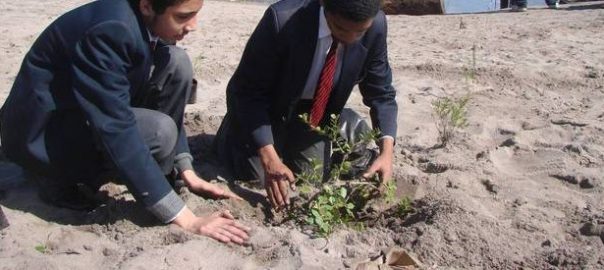
Leave a Reply